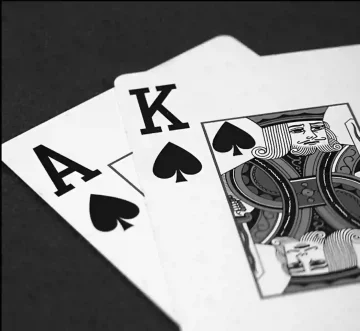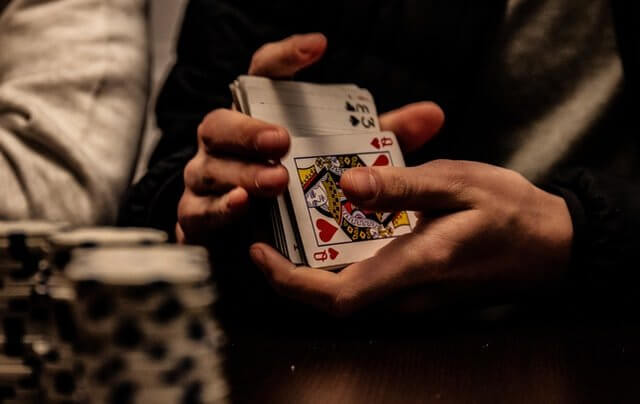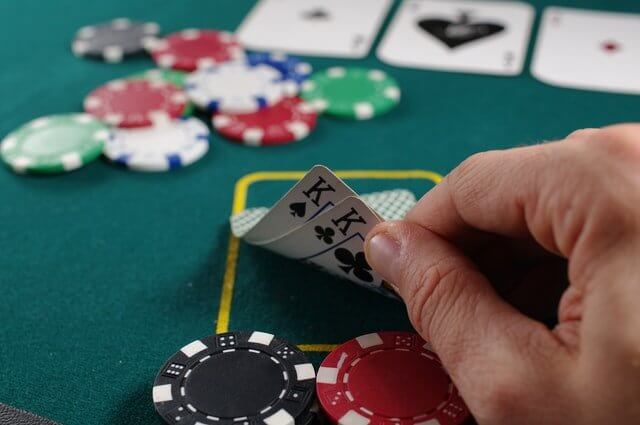Poker is a game of strategy, skill, and calculated decisions. One of the most critical concepts to master is understanding poker odds and outs, especially for Texas Hold’em players. These principles help you calculate the likelihood of improving your hand and guide your decision-making at every stage of the game. In this guide, we’ll break down poker odds and outs into simple, actionable steps.
If you’re interested in Omaha Poker, read our guide.

That being said, we’re here to provide a detailed guide on poker outs and poker odds, along with other major details surrounding these aspects.
What Are Poker Odds and Outs?
Before we get to the very core outs and odds, you may first want to learn about poker flops. Namely, flops stand for the first three or five community cards which a dealer places in the middle of the table.
These cards serve as a starting point for the game. Additionally, every player gets five cards at the beginning of a poker game. Needless to say, the goal is to have a better hand than your opponent. In order to do that, you will need to have hands, such as flushes or straights.
Flushes represent four consecutive cards of the same suit (e.g., four clubs). If you get a straight, it means that you have five consecutive cards of the same suit. This is when the term “draw” comes into play.
In other words, this term means that you have certain cards and that you need additional ones to have a made hand. Any card that can complete your hand is called an out.
To exemplify, we have a situation where two clubs and one heart is on the table. You hold two clubs in your hands. Any club card in the following round will give you a flush. If we know that there are 13 clubs in the deck, and you hold two while two are on the table, it means that the number of outs you have is nine.
How to Calculate Poker Odds?
Once you learn how to determine the number of outs you have, you can turn to calculating odds. Let’s go back to the previous example, where you hold two clubs, and two clubs are on the table.
We now know that you now have nine outs. To calculate odds, you will also need to determine the total number of cards that can appear in the following round. A deck consists of 52 cards. As said, there are three cards on the table and two in your hands.
Next, you should subtract the number of cards in a deck from those known to you (in this example, 52- 5 = 47). Finally, you need to divide the number of outs you have by the number of cards left to appear in the following rounds (9/47 = 0,19%, which means that you have a 19% chance to hit an out, which is close to 4:1).
Importantly, you have to disregard all your opponents’ cards when calculating poker odds. To illustrate this, we provide a table with poker hand odds and percentages below.
| Hand | Outs | Odds on Turn | Odds on River |
| Flush Draw | 9 | 19.1% (1.9:1) | 35.0% (1.9:1) |
| Open-Ended Straight Draw | 8 | 17.4% (4.9:1) | 31.5% (2.2:1) |
| Two Overcards | 6 | 13.0% (6.7:1) | 24.1% (3.2:1) |
| One Pair to Two Pair/Set | 5 | 10.9% (8.2:1) | 19.6% (4.1:1) |
| Gutshot (inside) straight draw | 4 | 8.7% (10.5:1) | 16.5% (5.1:1) |
| One Pair to Trips | 2 | 4.3% (22.5:1) | 8.4% (11.9:1) |
If you’re curious about what it means to be a poker grinder, check out our guide for all the details.
Poker Terms You Should Know
There are must-know terms for both beginner and advanced poker players. A glossary helps each player understand and perform better in this game. Here are the most common ones to keep an eye on.
This is the situation where you have four cards and need only one more to complete the hand of five cards of the same suit.
You have four cards and need to hit one out to have a straight, but there are four outs on one and four outs on the other end.
When there’s a sequence of cards (e.g., 5, 6, 7, and 9) and you need the missing one from that sequence, you actually have a gutshot draw.
Flush draws are simply the instances where you have three cards and need one out to have four cards of the same suit.
An overcard is a card of higher rank in comparison to the community cards or the ones in players’ hands. An undercard is completely the opposite of an overcard.
This term relates to drawing the two remaining cards that you need in order to have flush or straight. It refers to situations when a dealer reveals the fourth and the fifth cards in the fourth and fifth stages of a game.
How the Rule of 2 and 4 Simplifies Poker Odds Calculations
Texas Hold’em players can use a very useful rule of 2 and 4 to quickly calculate odds and percentages when playing against a clock. This rule is all about taking the number of outs you have and multiplying it with the doubled number of streets left.
The term “streets” here relates to the remaining rounds in a game. The stage when the fourth card is revealed is called the turn. The round when the last card is shown is the river.
Let’s imagine that the turn is about to come, and you have four outs. You should multiply the number of outs (four) with the doubled number of streets left (two). In the end, the 4×4 = 16, which is your rough percentage of hitting an out.
If there are three stages left and you have, let’s say, eight outs, you will need to simply multiply the number of outs you have by four. This way, you will get the rough percentage of hitting a win on the river (e.g., 8×4=32).

Practical Example: Counting Outs and Calculating Odds in Poker
To make things clearer, we’ve created a detailed step-by-step example of counting outs and calculating odds. You can check out each step to fully grasp these concepts.
- Identify Your Hand and Outs
| You have: 7♣️ 8♣️ | The flop is: 2♣️ K♣️ 9♥️ |
| You need one more club to complete a flush. There are 13 clubs in total, and you have 2 in your hand and 2 on the flop, leaving 9 clubs (outs) remaining. | |
- Calculate the Number of Unseen Cards
| Total cards in the deck | Cards you see (your hand + flop) | Unseen cards |
| 52 | 5 | 52 – 5 = 47 |
- Calculate the Odds for the Turn
| Number of outs | Unseen cards | Probability of hitting an out on the turn |
| 9 | 47 | 9/47 ≈ 0.191 or 19.1% |
- Calculate the Odds for the River if You Miss on the Turn
If you miss on the turn, you still have 9 outs and now 46 unseen cards. Probability of hitting an out on the river: 9/46 ≈ 0.196 or 19.6%
- Combine the Odds Using the Rule of 2 and 4
For the turn: Multiply outs by 2: 9 × 2 = 18%
For the river: Multiply outs by 4: 9 × 4 = 36%
- Example Conversion to Odds
Odds for the turn: 4.22 to 1 (47 cards – 9 outs = 38 non-outs; 38:9 simplified)
Odds for the river: 4.11 to 1 (46 cards – 9 outs = 37 non-outs; 37:9 simplified)
What Are Pot Odds?
Pot odds give you the pot size ratio in a given moment to the cost of a planned call. More specifically, calculating pot odds helps you decide whether you should call or fold.
You can calculate these odds with a well-known formula. For example, our opponent places a $30 bet into a $30 pot. In a situation where we’re calling $30 into a $30 pot, the formula to find out the pot odds is as follows:
- ($30 / ($30 + $60)) x 100
- ($30 / $90)) x 100
- 0,33 x 100 =33.3%
The example from above leads us to conclude that we need to win the hand 1/3 times in order for our call to make a profit. What we also need to do here is calculate the number of outs we have and use the “rule of 2 and 4” to determine our chances of making a hand.

If we imagine that we have four outs here, and the turn is about to come, then our chances of hitting an out are 16% (as explained before). Comparing our 16% chance of making the hand by the turn with the 33.3% win rate needed to beat our opponent reveals that we should fold here rather than call.
What Is Poker Equity and Why Does It Matter?
Equity serves the purpose of calculating the chances of a player winning a poker game if more than one player remains in the last betting round. To do this, you need to divide the number of remaining cards in a deck by the number of remaining streets.
For instance, a player may need one card to make a straight on the turn with three outs left. With 47 cards left in the deck, the formula (3/47 = 6.3%) provides us with equity or a player’s chances of winning. On the river, the same formula applies, with one card less as the game went one round further (3/46 = 6.5%).
Types of Poker Draws
The most common poker draws feature terms like hand, flop, outs, and specific outs. Hands stand for the cards a player is holding, while a flop refers to the first three to five dealt cards on the table.
Outs relate to the number of cards that can complete a hand, with the specific outs being the exact cards to help a player do this. In the table below, we include the examples of all these elements.
| Type of Draw | Hand | The Flop | Outs | Specific Outs |
| Flush Draw | A♠ 7♠ | K♠ 10♠ 2♦ | 9 | Remaining 9♠, 8♠, 6♠, 5♠, 4♠, 3♠, 2♠, Q♠, J♠ |
| Open-Ended Straight Draw | 8♣ 9♣ | 6♠ 7♦ K♣ | 8 | 5♠, 5♦, 5♣, 5♥, 10♠, 10♦, 10♣, 10♥ |
| Two Overcards | A♠ K♠ | 8♠ 9♦ 2♣ | 6 | A♦, A♣, A♥, K♦, K♣, K♥ |
| One Pair to Two Pair/Set | 9♠ 9♦ | Q♣ 6♠ 2♦ | 5 | 9♣, 9♥, Q♠, Q♦, Q♥ |
| Gutshot Straight Draw | 8♣ J♣ | 9♠ 10♦ K♣ | 4 | Q♠, Q♦, Q♣, Q♥ |
| One Pair to Trips | 9♠ 9♦ | Q♣ 6♠ 2♦ | 2 | 9♣, 9♥ |
Summary
The game of poker is not just a mere game of chance. The real proof of this is poker odds and outs, which help us determine our chances of winning a round or being the overall winner.
Calculating the pot odds also assists us with our decisions to call or draw. Lastly, knowing the most common terms and draws makes every round and the entire game easier to play.
FAQ
For concise information on poker essentials, you can read our FAQ section.
The odds of winning (usually shown in the percentage form) in poker are the calculated chances of a player winning a round or winning the game outright.
Pot odds compare the current pot size to the cost of a potential call. They help you decide whether to call or fold.
The best poker hand is Royal Flush, consisting of ace, king, queen, jack, and ten in a single hand.
If you are on the turn, you should multiply your outs by 2 to get your winning percentage on the river. The same rule involves multiplying your outs by four when you are on the flop.
Blockers are outs that you need to make a hand that other players hold in their hands at a given moment of play.
An ante is an obligatory hand that all contestants should play before a poker hand starts.






